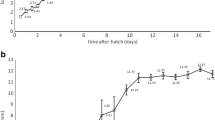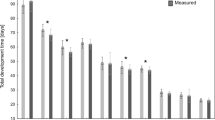Abstract
Megaselia scalaris (Schmitz, 1938) (Diptera: Phoridae) is a common insect in forensic science that is frequently found in indoor cases, particularly on corpses in closed environments. Although this species is useful for estimating the minimum postmortem interval (PMImin) in the absence of Calliphoridae, there is a lack of data on its development in China. Herein, we studied the development of M. scalaris exposed to seven constant temperatures ranging from 16 to 34 °C. The mean (± SD) developmental durations of M. scalaris from egg to adult stage at 16, 19, 22, 25, 28, 31, and 34 °C were 1486.9 ± 75.3, 823.7 ± 42.8, 448.2 ± 59.8, 417.7 ± 19.7, 297.2 ± 27.3, 272.9 ± 10.4, and 253.0 ± 5.0 h, respectively. The mean (± SE) lower developmental threshold temperature (TL) and the thermal summation constant (K) were determined by a linear model as 12.69 ± 0.3 °C and 4965.8 ± 227.9-degree hours, respectively. A nonlinear model estimated the lower developmental threshold temperature, intrinsic optimum temperature, and upper lethal developmental threshold temperature as 14.58, 21.00, and 34.15 °C, respectively. We established three development models to estimate the age of the immature insect, namely the isomegalen diagram, isomorphen diagram, and thermal summation model. In addition, a regression analysis of the relationship between body length and total development time from hatching to pupariation was performed. Our findings provide a basis for applications of M. scalaris in PMImin estimations.





Similar content being viewed by others
Data availability
The datasets generated during the current study are available from the corresponding author upon reasonable request.
References
Alibegović A (2014) Cartilage: a new parameter for the determination of the postmortem interval? J Forensic Leg Med 27:39–45. https://doi.org/10.1016/j.jflm.2014.08.005
Gennard DE (2007) Forensic entomology: an introduction. John Wiley & Sons, Chichester, England
Anderson GS (2001) Forensic entomology in British Columbia: a brief history. J Entomol Soc Br Columbia 98:127–136
Tomberlin JK, Mohr R, Benbow ME et al (2011) A roadmap for bridging basic and applied research in forensic entomology. Annu Rev Entomol 56:401–421. https://doi.org/10.1146/annurev-ento-051710-103143
Amendt J, Richards CS, Campobasso CP et al (2011) Forensic entomology: applications and limitations. Forensic Sci Med Pathol 7:379–392. https://doi.org/10.1007/S12024-010-9209-2
Wang Y, Wang J, Wang Z, Tao L (2017) Insect succession on pig carcasses using different exposure time - a preliminary study in Guangzhou, China. J Forensic Leg Med 52:24–29. https://doi.org/10.1016/j.jflm.2017.08.002
Martín-Vega D, Gómez-Gómez A, Baz A (2011) The “Coffin Fly”Conicera tibialis (Diptera: Phoridae) breeding on buried human remains after a postmortem interval of 18 years. J Forensic Sci 56:1654–1656. https://doi.org/10.1111/j.1556-4029.2011.01839.x
Disney RHL, Manlove JD (2005) First occurrences of the Phorid, Megaselia abdita, in forensic cases in Britain. Med Vet Entomol 19:489–491. https://doi.org/10.1111/j.1365-2915.2005.00593.x
Pohjoismäki JLO, Karhunen PJ, Goebeler S et al (2010) Indoors forensic entomology: colonization of human remains in closed environments by specific species of sarcosaprophagous flies. Forensic Sci Int 199:38–42. https://doi.org/10.1016/j.forsciint.2010.02.033
Reibe S, Madea B (2010) How promptly do blowflies colonise fresh carcasses? A study comparing indoor with outdoor locations. Forensic Sci Int 195:52–57. https://doi.org/10.1016/j.forsciint.2009.11.009
Benecke M, Josephi E, Zweihoff R (2004) Neglect of the elderly: forensic entomology cases and considerations. Forensic Sci Int 146:S195–S199. https://doi.org/10.1016/J.FORSCIINT.2004.09.061
Campobasso C, Henry R, Disney L, Introna F (2004) A case of Megaselia scalaris (Loew) (Dipt., Phoridae) breeding in a human corpse. Anil Aggrawal’s Internet J Forensic. Med Toxicol 5(1):3–5
Syamsa RA, Omar B, Ahmad FMS et al (2017) Comparative fly species composition on indoor and outdoor forensic cases in Malaysia. J Forensic Leg Med 45:41–46. https://doi.org/10.1016/j.jflm.2016.12.002
Sanford MR (2015) Forensic entomology in the medical examiner’s office. Acad Forensic Pathol 5:306–317. https://doi.org/10.23907/2015.034
Goff M (1991) Comparison of insect species associated with decomposing remains recovered inside dwellings and outdoors on the island of Oahu, Hawaii. J Forensic Sci 36:748–753. https://doi.org/10.1520/JFS13085J
Bugelli V, Forni D, Bassi LA et al (2015) Forensic entomology and the estimation of the minimum time since death in indoor cases. J Forensic Sci 60:525–531. https://doi.org/10.1111/1556-4029.12647
Reibe S, Madea B (2010) Use of Megaselia scalaris (Diptera: Phoridae) for post-mortem interval estimation indoors. Parasitol Res 106:637–640. https://doi.org/10.1007/s00436-009-1713-5
Disney RHLL (2008) Natural history of the scuttle fly, Megaselia scalaris. Annu Rev Entomol 53:39–60. https://doi.org/10.1146/annurev.ento.53.103106.093415
Beaver RA (1987) Biological studies of non-muscoid flies (Diptera) bred from mollusc carrion in Southeast Asia. Med Entomol Zool 38:187–195. https://doi.org/10.7601/MEZ.38.187
Walker TJ (1957) Ecological studies of the arthropods associated with certain decaying materials in four habitats. Ecology 38:262–276. https://doi.org/10.2307/1931685
Disney RHL (1994) Scuttle flies: the Phoridae. Springer, Netherlands, Dordrecht
Yunus A, Ho TN (1980) List of economic pests, host plants, parasites and predators in West Malaysia (1920-1978). Ministry of Agriculture, Malaysian Agri, Kuala Lumpur
Idris AB, Abdullah M (1999) Megaselia scalaris (Loew) (Diptera: Phoridae) in Malaysia. Malayan Nat J 53:345–348 ST-Megaselia scalaris (Loew) (Diptera
Idris AB, Abdullah M, Lin TP (2001) Effect of various diets on the development of scuttle fly, Megaselia scalaris (Loew) (Diptera: Phoridae), larvae and pupae and percent of adult emergence and longevity. Pakistan J Biol Sci 4:321–325. https://doi.org/10.3923/pjbs.2001.321.325
Idris AB, Abdullah M (1997) The phorid fly, Megaselia scalaris (Loew), as a candidate for managing molluscicide-resistant round snail, reported as parasitized by phorid flies Bradybaena similaris (Ferussas). Resist Pest Manag 9:28–29
Solgi R, Dinparast Djadid N, Eslamifar A et al (2017) Morphological and molecular characteristic of Megaselia scalaris (Diptera: Phoridae) larvae as the cause of urinary myiasis. J Med Entomol 54:781–784. https://doi.org/10.1093/jme/tjw204
Singh TS, Rana D (1989) Urogenital myiasis caused by Megaselia scalaris (Diptera: Phoridae): a case report. J Med Entomol 26:228–229. https://doi.org/10.1093/JMEDENT/26.3.228
Sukontason KL, Boonsriwong W, Siriwattanarungsee S et al (2006) Morphology of puparia of Megaselia scalaris (Diptera: Phoridae), a fly species of medical and forensic importance. Parasitol Res 98:268–272. https://doi.org/10.1007/s00436-005-0052-4
Harrison DA, Cooper RL (2003) Characterization of development, behavior and neuromuscular physiology in the phorid fly, Megaselia scalaris. Comp Biochem Physiol - A Mol Integr Physiol 136:427–439. https://doi.org/10.1016/S1095-6433(03)00200-9
Greenberg B, Wells JD (1998) Forensic use of Megaselia abdita and M. scalaris (Phoridae: Diptera): case studies, development rates, and egg structure. J Med Entomol 35(3):205–209
Zuha RM, Omar B (2014) Developmental rate, size, and sexual dimorphism of Megaselia scalaris (Loew) (Diptera: Phoridae): its possible implications in forensic entomology. Parasitol Res 113:2285–2294. https://doi.org/10.1007/s00436-014-3883-z
Miranda-Miranda E, Cossio-Bayugar R, Martinez-Ibañez F, Bautista-Garfias CR (2011) Megaselia scalaris reared on Rhipicephalus (Boophilus) microplus laboratory cultures. Med Vet Entomol 25:344–347. https://doi.org/10.1111/j.1365-2915.2010.00930.x
Prawirodisastro M, Benjamin DM (1979) Laboratory study on the biology and ecology of Megaselia scalaris (Diptera: Phoridae). J Med Entomol 16:317–320. https://doi.org/10.1093/jmedent/16.4.317
Trumble JT, Pienkowski RL (1979) Development and survival of Megaselia scalaris (Diptera, Phoridae) at selected temperatures and photoperiods. Proc Entomol Soc Wash 81:207–210
Zuha RM, Ankasha SJ, Disney RHL, Omar B (2016) Indoor decomposition study in Malaysia with special reference to the scuttle flies (Diptera: Phoridae). Egypt J Forensic Sci 6:216–222. https://doi.org/10.1016/j.ejfs.2015.09.002
Hu Y, Yuan X, Zhu F, Lei C (2010) Development time and size-related traits in the oriental blowfly, Chrysomya megacephala along a latitudinal gradient from China. J Therm Biol 35:366–371. https://doi.org/10.1016/j.jtherbio.2010.07.006
Gallagher MB, Sandhu S, Kimsey R (2010) Variation in developmental time for geographically distinct populations of the common green bottle fly, Lucilia sericata (Meigen). J Forensic Sci 55:438–442. https://doi.org/10.1111/j.1556-4029.2009.01285.x
Wang Y, Zhang Y, Hu G et al (2020) Development of Megaselia spiracularis (Diptera: Phoridae) at different constant temperatures. J Therm Biol 93:102722. https://doi.org/10.1016/j.jtherbio.2020.102722
Ikemoto T, Takai K (2000) A new linearized formula for the law of total effective temperature and the evaluation of line-fitting methods with both variables subject to error. Environ Entomol 29:671–682. https://doi.org/10.1603/0046-225X-29.4.671
Shi P, Ikemoto T, Egami C et al (2011) A modified program for estimating the parameters of the SSI model. Environ Entomol 40:462–469. https://doi.org/10.1603/EN10265
Vasconcelos SD, Soares TF, Costa DL (2014) Multiple colonization of a cadaver by insects in an indoor environment: first record of Fannia trimaculata (Diptera: Fanniidae) and Peckia (Peckia) chrysostoma (Sarcophagidae) as colonizers of a human corpse. Int J Legal Med 128:229–233. https://doi.org/10.1007/s00414-013-0936-2
Frątczak-Łagiewska K, Grzywacz A, Matuszewski S (2020) Development and validation of forensically useful growth models for Central European population of Creophilus maxillosus L. (Coleoptera: Staphylinidae). Int J Legal Med 134:1531–1545. https://doi.org/10.1007/S00414-020-02275-3
Richards CS, Villet MH (2009) Data quality in thermal summation development models for forensically important blowflies. Med Vet Entomol 23:269–276. https://doi.org/10.1111/j.1365-2915.2009.00819.x
Midgley JM, Villet MH (2009) Development of Thanatophilus micans (Fabricius 1794) (Coleoptera: Silphidae) at constant temperatures. Int J Legal Med 123:285–292. https://doi.org/10.1007/s00414-008-0280-0
Owings CG, Spiegelman C, Tarone AM, Tomberlin JK (2014) Developmental variation among Cochliomyia macellaria Fabricius (Diptera: Calliphoridae) populations from three ecoregions of Texas, USA. Int J Legal Med 128:709–717. https://doi.org/10.1007/s00414-014-1014-0
Thomas JK, Sanford MR, Longnecker M, Tomberlin JK (2016) Effects of temperature and tissue type on the development of Megaselia scalaris (Diptera: Phoridae). J Med Entomol 53:519–525. https://doi.org/10.1093/jme/tjw019
Zuha RM, Razak TA, Ahmad NW, Omar B (2012) Interaction effects of temperature and food on the development of forensically important fly, Megaselia scalaris (Loew) (Diptera: Phoridae). Parasitol Res 111:2179–2187. https://doi.org/10.1007/s00436-012-3070-z
Pietro CC, Di Vella G, Introna F (2001) Factors affecting decomposition and Diptera colonization. Forensic Sci Int 120:18–27. https://doi.org/10.1016/S0379-0738(01)00411-X
Byrd JH, Tomberlin JK (2019) Forensic entomology: the utility of arthropods in legal investigations, 3rd edn. CRC Press, Boca Raton
Ong S, Ahmad H, Tan EH (2018) Substrate moisture affects the development of Megaselia scalaris ( Diptera : Phoridae ): an implication of the growth circumstances of the fly in forensic entomology. Environ Entomol 47:1582–1585. https://doi.org/10.1093/ee/nvy127
Boonchu N, Sukontason K, Sukontason KL et al (2004) Observations on first and second-instar larvae of Megaselia scalaris (Loew) (Diptera: Phoridae). J Vector Ecol 29:79–83
Lee YM, Disney RHL, Zuha RM (2021) Development of forensically important scuttle fly, Megaselia spiracularis Schmitz (Diptera: Phoridae) at ambient temperatures with distinguishing features of the larval instars. J Asia Pac Entomol 24:858–865. https://doi.org/10.1016/j.aspen.2021.07.013
Sukontason KL, Sukontason K, Lertthamnongtham S, Boonchu N (2002) Surface ultrastructure of third-instar Megaselia scalaris (Diptera: Phoridae). Mem Inst Oswaldo Cruz 97:663–665. https://doi.org/10.1590/S0074-02762002000500014
Dian-Xing F, Guang-Chun L (2012) Morphology of immature stages of Megaselia spiracularis Schmitz (Diptera: Phoridae). Microsc Res Tech 75:1297–1303. https://doi.org/10.1002/jemt.22064
Acknowledgements
We thank Dr. Guangchun Liu and Dr. Dianxing Feng (Shenyang University, China) for identifying the collected specimens.
Funding
This study was supported by the National Natural Science Foundation of China (grant numbers 32070508, 31872258, and 82002007) and the Priority Academic Program Development of Jiangsu Higher Education.
Author information
Authors and Affiliations
Contributions
Investigation: Yanan Zhang and Mingqing Liao; methodology: Jiangfeng Wang and Yu Wang; formal analysis and investigation: Liangliang Li, Yu Wang, Chengtao Kang, Gengwang Hu, and Guo Yi; writing—original draft preparation: Yanan Zhang; writing—review and editing: Jiangfeng Wang and Yu Wang; funding acquisition: Jiangfeng Wang; supervision: Jiangfeng Wang. All authors commented on previous versions of the manuscript. All authors read and approved the final manuscript.
Corresponding authors
Ethics declarations
Ethical approval
All animal studies were approved by the Institutional Animal Care and Use Committee (IACUC) and carried out under the policies of Soochow University.
Informed consent
Not applicable
Conflict of interest
The authors declare no competing interests.
Additional information
Publisher’s note
Springer Nature remains neutral with regard to jurisdictional claims in published maps and institutional affiliations.
Rights and permissions
Springer Nature or its licensor (e.g. a society or other partner) holds exclusive rights to this article under a publishing agreement with the author(s) or other rightsholder(s); author self-archiving of the accepted manuscript version of this article is solely governed by the terms of such publishing agreement and applicable law.
About this article
Cite this article
Zhang, Y., Li, L., Liao, M. et al. Development of Megaselia scalaris at constant temperatures and its significance in estimating the time of death. Int J Legal Med 138, 97–106 (2024). https://doi.org/10.1007/s00414-023-02993-4
Received:
Accepted:
Published:
Issue Date:
DOI: https://doi.org/10.1007/s00414-023-02993-4




